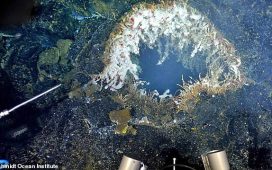The UK Government has given the go-ahead for a controversial plan to store 100 million tonnes of carbon dioxide (CO2) beneath the North Sea.
Regulators have given Northern Endurance Partnership – a coalition of energy companies led by BP and Equinor – a licence to start pumping CO2 to a site nearly a kilometre beneath the seabed.
Starting in 2027, the new ‘carbon capture and storage’ facility will store four million tonnes of liquified CO2 per year in an underground aquifer off the Yorkshire coast.
Energy Secretary Ed Miliband says: ‘This investment launches a new era for clean energy in Britain – boosting energy security, backing industries, and supporting thousands of highly skilled jobs in Teesside and the North East.
‘This is the Government’s mission to make the UK a clean energy superpower in action- replacing Britain’s energy insecurity with homegrown clean power that rebuilds the strength of our industrial heartlands.’
While carbon capture has been hailed as a vital step towards securing a net zero future for the UK, many experts have raised concerns about the long-term safety of storing carbon deep beneath the sea.
Previous studies have shown that even small amounts of escaping CO2 can have a massive impact.
For example, if CO2 escapes through natural faults or poorly sealed wells, it could taint water supplies with deadly metals – including arsenic, lead, and uranium.

The UK has given the green light to a controversial carbon capture and storage project which aims to pump 100 million tonnes of CO2 beneath the North Sea

Northern Endurance Partnership has been awarded the UK’s first permit to take CO2 generated by carbon capture projects near Teesside and inject this into an expended oil field almost a kilometre beneath the seabed
As power plants burn fossil fuels, they produce CO2 – a powerful greenhouse gas responsible for warming the Earth’s climate.
So, as the UK’s energy demands increase, there has been a growing need for a method of reducing the emissions that energy production releases into the air.
Carbon Capture and Storage (CCS) is a relatively new technology that prevents this carbon from reaching the atmosphere by permanently sequestering it out of the way.
Power plants are fitted with huge metal scrubbers which separate the harmful CO2 from the surrounding air.
This gas is compressed to the point where it forms a ‘supercritical liquid’ and begins to behave more like a fluid than a gas.
The liquid CO2 is then transported by pipes to a deep-underground structure such as an underground cavern, a depleted oil or gas reservoir, or a formation of porous rocks that have good gas storage potential, known as a saline aquifer.
In theory, CO2 will remain in this new reservoir rather than entering the atmosphere and contributing to climate change.
The decision to grant Northern Endurance Partnership (NEP) the country’s first carbon storage permit is a significant step towards this technology becoming more common.

Carbon Capture projects use huge metal ‘air scrubbers’ to pull CO2 out of the surrounding air so that it can be safely removed from the environment. Pictured: The Mammoth carbon capture facility in Switzerland
Once operational, NEP’s new carbon capture project has the potential to store up to 100 million tonnes of carbon over the next 25 years.
According to the North Sea Transition Authority, which awarded the permit, this would be the equivalent of taking 58.8 million cars off the road for a year.
The permit has also been issued alongside an Economic Licence which allows bp, Equinor, and TotalEnergies to start installing infrastructure at the site 75km east of Flamborough Head.
However, the move also appears to confirm one of the biggest criticisms of CCS.
Many have pointed out that carbon capture doesn’t actually lead to any reductions in carbon emissions since it is only used as an excuse to invest in more fossil fuels.
In this case, the move to invest more in CCS comes at the exact same time as the approval of a new gas-burning power plant at Teesside.
NZT Power, a joint venture between bp and Equinor, has entered into the final stages of a £4bn project to produce 742 megawatts of energy.
Only 2 million tonnes of CO2 per year will be captured at the plant before being stored by NEP.

Secretary of State for Energy Security and Net Zero, Ed Miliband, has promised £21.7 billion of investment in carbon capture facilities around the UK
This means that the government’s claim that the plan will slash the UK’s carbon emissions doesn’t stand up to scrutiny.
Mike Childs, head of policy at environmental organisation Friends of the Earth, previously said the government is just ‘championing more costly and dirty fossil fuels’.
He added: ‘Even if it ever worked, which is unlikely in the near term, CCS won’t capture all the climate pollution caused by burning fossil fuels or address the significant emissions that are created when gas and oil is extracted.’
Likewise, CCS often directly enables more fossil fuels to be burned through a process called ‘enhanced oil recovery’.
This process pumps pressurised carbon into partly depleted oil reservoirs to force the remaining fossil fuels to the surface.
According to the Global Carbon Capture and Storage Institute’s 2023 survey, at least 30 of the 43 CCS projects worldwide are built for enhanced oil recovery.
That means the main use for CCS around the world is to produce more oil.
The Endurance site will not be used for this purpose but it shows that the environmental credentials of the technology are far from clear.

The government has already granted 26 further licences for CCS projects around the UK, with a second permit expected to be granted in the coming months. By 2030, the UK could store 20-30 million tonnes of CO2 per year

This comes alongside the approval of the NZT Power ‘net zero’ gas-burning power plant (pictured) in Teesside which will use the carbon capture project to store the emissions it produces
The UK is believed to have room to store a potential 78 gigatonnes of carbon in natural aquifers and depleted oil reservoirs with 78 billion tonnes of storage capacity in the North Sea alone.
However, some experts have raised concerns over the long-term safety of CCS.
The biggest risk is that CO2 from underground reservoir escapes through small cracks and begins to leak out into the surrounding waters.
This is a particular problem for Endurance and the other North Sea sites since former oil fields have some of the biggest risks of leaking.
While there is very little chance that carbon will escape from faults in the rock even during an earthquake, former oil wells can offer an escape route for the trapped gas.
A 2021 paper, published in Earth-Science Reviews, noted that a ‘poor cement job’ was the biggest source of CO2 leaks.
This process is already happening as carbon in the atmosphere dissolves into the ocean, weakening coral skeletons and the shells of animals like crabs, lobsters, and muscles.
Yet the amounts of CO2 leaked by carbon capture sites are not likely to be large enough to significantly impact the ocean.
As of this year, there are more than 40 CCS projects around the world and the amount of CO2 being leaked from any site has been exceptionally low.
The International Council on Clean Transportation concluded in 2020 that carbon storage solutions are expected to leak less than one per cent of their stored CO2 over a 1,000-year period.
But, on a local scale, even a small CO2 leak could lead to significant health and environmental impacts.
Studies have shown that, as leaking CO2 increases the acidity of the water supply, it increases the rate at which nearby metals dissolve.
One 2011 study showed that even tiny amounts of CO2 drove up the levels of metals including manganese, cobalt, nickel, and iron tenfold in some locations.
Worryingly, the researchers also observed increases in potentially dangerous barium and uranium.
Further studies published in 2016 and 2017 also showed that leaking CO2 also facilitated the release of deadly arsenic into the nearby aquifer.
If these chemicals were to enter the water supply, it could create a risk to public health.

When CO2 leaks into the water it creates acid which rapidly dissolves surrounding minerals. In pictures ‘a’ and ‘c’ you can see the pits formed in mineral samples after being exposed to CO2. This process can lead to lead, arsenic, and even uranium leaking into the water

However, due to the layer of impermeable ‘cap rock’ which sits above the carbon reservoir, the chance of large quantities of CO2 escaping is very low
However, the North Sea Transition Authority maintains that the NEP carbon storage project is entirely safe.
In order to receive a permit, the site must show that there is no risk of CO2 leaking and that there is no harm to the environment.
While it does not rule out the possibility of an unexpected leak, the rocks above the carbon reservoir are impermeable to CO2, preventing the gas from escaping.
Although there is some risk of a leak through an unsecured oil well, the government maintains that these could be quickly sealed before any serious damage is done.










